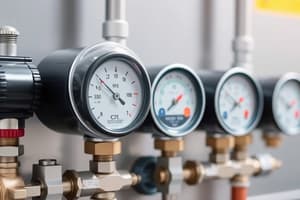Podcast
Questions and Answers
Which of the following is a type of expansion valve?
Which of the following is a type of expansion valve?
- Centrifugal pump
- Scroll compressor
- Rotary vane
- Fixed orifice (correct)
What force primarily acts to open a TXV?
What force primarily acts to open a TXV?
- Spring pressure
- Head pressure
- Bulb pressure (correct)
- Suction pressure
Which force acts to close a TXV?
Which force acts to close a TXV?
- Bulb pressure
- Suction pressure (correct)
- Condenser pressure
- Evaporator pressure
Which of the following is a type of charge found in a TXV bulb?
Which of the following is a type of charge found in a TXV bulb?
When is an external equalizer typically needed on a TXV?
When is an external equalizer typically needed on a TXV?
Where is the TXV bulb typically located?
Where is the TXV bulb typically located?
What happens to an EXV when the load increases?
What happens to an EXV when the load increases?
What happens to a TXV when superheat increases?
What happens to a TXV when superheat increases?
How is a TXV system typically charged?
How is a TXV system typically charged?
How is a fixed bore metering device system typically charged?
How is a fixed bore metering device system typically charged?
Does a fixed metering device maintain a constant superheat?
Does a fixed metering device maintain a constant superheat?
If a TXV bulb loses its charge, what happens to the system pressure?
If a TXV bulb loses its charge, what happens to the system pressure?
Which expansion valve maintains a constant superheat?
Which expansion valve maintains a constant superheat?
Which of the following is NOT an opening force on a TXV?
Which of the following is NOT an opening force on a TXV?
What kind of charge ensures the TXV responds quickly to temperature changes?
What kind of charge ensures the TXV responds quickly to temperature changes?
What can happen if the pressure drop is too high without an external equalizer?
What can happen if the pressure drop is too high without an external equalizer?
What does the TXV bulb sense at the outlet of the evaporator?
What does the TXV bulb sense at the outlet of the evaporator?
When does the EXV close?
When does the EXV close?
When should superheat increase?
When should superheat increase?
What system is best described as a precise liquid feed?
What system is best described as a precise liquid feed?
Flashcards
Types of expansion valves?
Types of expansion valves?
Fixed orifice, TXV (thermostatic expansion valve), AXV (automatic expansion valve).
Opening force on a TXV?
Opening force on a TXV?
Bulb pressure
Closing forces on a TXV?
Closing forces on a TXV?
Suction pressure, spring pressure.
TXV bulb charges?
TXV bulb charges?
Signup and view all the flashcards
When use external equalizer?
When use external equalizer?
Signup and view all the flashcards
TXV bulb location?
TXV bulb location?
Signup and view all the flashcards
EXV response to load increase?
EXV response to load increase?
Signup and view all the flashcards
TXV response when superheat increases?
TXV response when superheat increases?
Signup and view all the flashcards
How to charge TXV system?
How to charge TXV system?
Signup and view all the flashcards
Device system charged?
Device system charged?
Signup and view all the flashcards
Fixed Metering device maintains superheat?
Fixed Metering device maintains superheat?
Signup and view all the flashcards
Effect of TXV bulb charge lost?
Effect of TXV bulb charge lost?
Signup and view all the flashcards
Study Notes
- Three types of expansion valves are fixed orifice, TXV (thermostatic expansion valve), and AXV (automatic expansion valve).
- The opening force on a TXV is bulb pressure.
- The closing forces on a TXV are suction pressure and spring pressure.
- Four different charges in a TXV bulb are vapor, liquid, cross liquid, and cross vapor.
- An external equalizer is needed on a TXV when the pressure drop on the evaporator exceeds 2.5 psig.
- The bulb for a TXV is located at the outlet of the evaporator.
- When the load increases, an EXV opens.
- When superheat increases, a TXV opens.
- A TXV system is charged by subcooling.
- A fixed bore metering device system is charged by superheat.
- A fixed metering device does not maintain superheat.
- If a TXV bulb loses its charge, suction and discharge pressure falls.
Studying That Suits You
Use AI to generate personalized quizzes and flashcards to suit your learning preferences.

